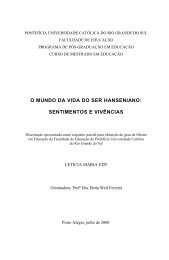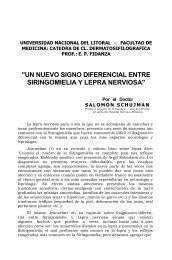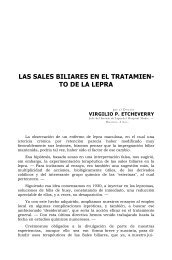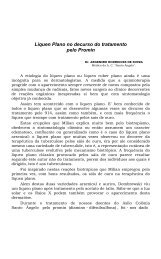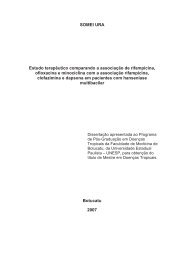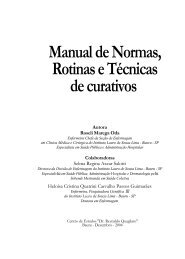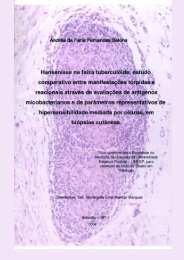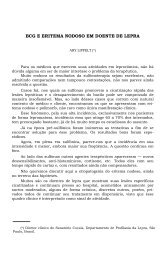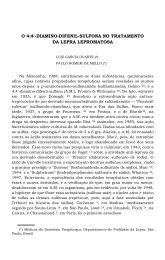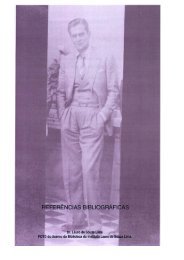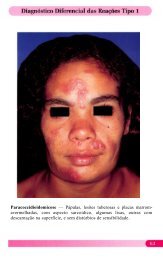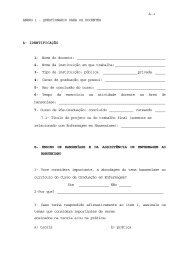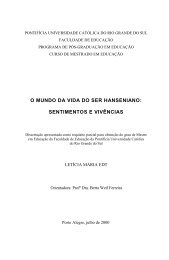MICROBIOLOGY - Index of
MICROBIOLOGY - Index of
MICROBIOLOGY - Index of
Create successful ePaper yourself
Turn your PDF publications into a flip-book with our unique Google optimized e-Paper software.
122A ^ hiternntintrr(l ,Inlu'/ UlI <strong>of</strong> Lepi'e.1.V ^ 1998<br />
Gelatin minimal (CM) medium :;upplemented with<br />
sodium palmitate was further supplemented with 5% Dextrin,<br />
2% F'ructose, Actinomycin O at 50 ug/ml concentration<br />
and Chis medium was inoculated with 10 1- 106<br />
CFU/ml ol' ira vitro maintained CAN bacteria which was<br />
allowed to grow for 4-6 weeks. Morphology was studied<br />
every •week by ataining with acid fast atais, Oram stain<br />
and Ciemsa stain. Control medium was CM without these<br />
supplements. The resulta showed unequivocal reversion<br />
<strong>of</strong> is vitro nos-acid fast bacillary, mycelial and<br />
granular forms <strong>of</strong> CAN bacteria to typical acid fast<br />
bacilli seen ira vivo ia LL leprosa. The rol• <strong>of</strong> individual<br />
factor by a process <strong>of</strong> elimination has bern determined<br />
and evaluated.<br />
M149<br />
OXIDATION OF "C-PALMITATE AS AN INDEX OF INFECTIVITI' AND<br />
VIABILITY OF 'FAST AND 'SLOW GROWING \I LEPRAIi ISOLATES<br />
R W Truman. S O Franrblau. R.51. Sandhez. A. listras<br />
G.\V L. lianse i s Discasc Center. /Imo Rouge. Louuuuu. USA<br />
Though there are as cot no recognvcd strams <strong>of</strong> .1/ hrrur, san.mis<br />
w lnch cshcbn 'for or erossih in U¢ mouse foot pad halo bois desembolo<br />
The factors w h¢h underhe these sanam Imos are nm yet undcnhwd. We<br />
cvmparcd the nmtabrhe acto ny and infetam aí ditTcrent preparamos <strong>of</strong> 1f.<br />
leprr ncluding knmm Yast' and 'siais' gruo mg isolai.. Inocula were<br />
compare/1 hetwcen Ireshls hanested l/. l.`ru, with assue preparanons and<br />
suspensions prescned at difercnt tempo,. secas and titiles. A mulher <strong>of</strong> goai<br />
handlmg pracnces are noted 5letabohe acuovy o as tssessed as the ninava<br />
abJm <strong>of</strong> Id 11 (error m ostdac "C-Pahmuln m xtiddlebrook 71112 IBacTcct<br />
mvbatctl at 33C and nas espressed as a growth rodes (GIL Inf ctntty was<br />
delermined u ing lhe mouse foot pad rechmque Arnuaddlos viera inoculated<br />
with some preparations The metabolic acusas <strong>of</strong> .11. (Troe 5aned nurkedls lis<br />
ias time <strong>of</strong> ongut, tirocine <strong>of</strong> preparation, duraoon <strong>of</strong> storage. and general<br />
character <strong>of</strong> the tssuc from schich u vias denc ed. The GI <strong>of</strong> freshly hanested<br />
preparanons were roughly bunod.dic correlatcd sc uh infecto ny. Prcpamnons<br />
onh low GI teuded to silos favor io no growth UNO rcutoculauon iam animais<br />
w indo Ihose ardi high GI usudn achicvcJ good growth results. Abuse rir bclow<br />
a threslmld, the GI was 1101 proportional to growth rate and nas no[ assonated<br />
with 'Ciar or 'sino' growth charactensucs <strong>of</strong> different isolares Preparatans held<br />
at 4-33C showed first an uicrease and troar a gradual decline m GI omer a 4 soa<br />
pcnod, but mfcctmny tias lost rapidls and generally climmalcd by 3 ssecks.<br />
Prcpamnons hcld at 1C for leis bati 7 das s retained bati Infectas ny. Metabohc<br />
acheis rias noa deteclable follosing a single freeze-th:nv <strong>of</strong> assue rir hanllar<br />
suspension and was generally assocmted with a 991' or grcater decline is<br />
infectas Grossth results achionahlc altar inocuiation <strong>of</strong> amoadillos and mica<br />
were comparable. Oddation <strong>of</strong> "C-palmnate can be used etTccus elo as a relativa<br />
meosurn <strong>of</strong> the qualin daí lapso preparammns The l ack <strong>of</strong> linear correlation<br />
hctwecn metabolic activity and 'fase rir'tios' growth charactenstic suggcsts that<br />
dilTerenual growth rates are minerem and nos be useful markers to help idcntdy<br />
saram sanants.<br />
MI50<br />
CULTURE :\ ND PATI(OGENIC CIIARACTERISTICS OP THE<br />
SI)COH.1CIERIC:V LEPRA!: ISOLATE "TI L 1-53" IN<br />
:ARNIADILLOS (D.impus.VOIGIIC/.VCIU1).<br />
R W Tnrman D Nl. Scollard, R.NI. Sanchez.<br />
G\VL Hansen's Disease Center, Bacon Rouge, Louisiana, USA<br />
Though no venetic variation has bens detected in .t1./Ursa<br />
from difierent patients, regions and animal hosts, some isolares can be<br />
distinguished by their dilierential growth rates the mouse foot pad.<br />
Tltai-53-.1/. /rprae is a weil characterized "fast" growing isolate<br />
commoniy propaeated is athvmic sede erice. To determine ias<br />
pathogenic characteristics is another host ase inoculated 2 groups o)'<br />
10 armadillos with 1.9 X 10' bacilli and compared their time course <strong>of</strong><br />
serological, hcmatological and histopathological esents <strong>of</strong> their<br />
infection with those <strong>of</strong> olhar animais inoculated with bacilli passaged<br />
from humans to armadillos. Thai-53 showed high metabolic activity<br />
for oxidation <strong>of</strong> "C-palmitate. Consistent with ias growth<br />
characteristics is the nade mouse, Thai-53 inoculated armadillos<br />
showed more a rapid progression <strong>of</strong> infection, decelopine fully<br />
dissentinated leprosy within 8-12 months with ali classical signa <strong>of</strong> the<br />
disease. Serological antibodv protiles for infection with Thai-53 were<br />
low and inconsistent is comparison to that seen with olhar isolates<br />
and the bacilli did noa comntonly disseminara to distant somatic sitos<br />
prior to the animais entering the terminal stages <strong>of</strong> discase. Necrupsy<br />
exantination showed that armadillos infected with Thai-53 had<br />
extensiva neurological involvement. Intcrspecies transfer <strong>of</strong> bacilli do<br />
noa ettect their oscrt pathogenicity and similar culture characteristic<br />
can he observed is dilierent hosts.<br />
MIS1<br />
EFFECT OF UV RADIATION ON .IIFCOHAC/ER/CM LE1'H.-I F.<br />
R 51' Truman T 1' Gillis<br />
G W Lung llanseti s Discas,: Conter, Baton Rouge, La USA<br />
The relatice impunance is Ieprosy transmission <strong>of</strong> contantinated dust,<br />
druplets or fun dias remain unclear .111csiorr.•rrran l.Trac is as<br />
extremely slow erow ing ohligate intraccllular parasite which is yet to<br />
be cultivated os artificial media. Seseral onvirunmental factors could<br />
limit ias [ransntissibility and survival ira sature including ias Coloras e to<br />
ultraciolet radiation (UV). In the laboratory, UV-C is generally<br />
recognized as a potent sterilizing aid bar ias etfectiveness aeainst ,i/.<br />
lepra,' alvo has sol beco shosn. \Ve exantined tine intluertce <strong>of</strong> UV os<br />
the growth and metabolic activity <strong>of</strong> Al. lepra.: Tesnporary static<br />
culturas ira I Ox35mm polystyrene petri dishes with 500 ui 71112 media<br />
containing Ix10' .1/. 1./rrae obtained front foot pads <strong>of</strong> nade mico<br />
were exposed to varving timed interva)s <strong>of</strong> U1• radiation generated<br />
from as artificial source Exposure limes ranged from 0-80 secundo<br />
and constitrited doses totaling from 0-1 2_.64x10' ERGS/est i o The<br />
bacilli were irnmediately resuvpended and I x10' oreanisms from each<br />
exposure dose were inoculated isto BacTec 12B vi.ds to assess for<br />
metabolic eticets Another 1x10' bacilli from each exposure acere<br />
inoculated Unto the foot pads <strong>of</strong> Balb/c coice )NIFP) to assess Ione<br />
ter naeticets<br />
o0 cell disision. The growth index achieved is BacTec<br />
cultores showed an immediate dose response related decline to a<br />
minimum <strong>of</strong> about 50% <strong>of</strong> the control activity afiar exposure to<br />
6 3x10' ERGS/cot'. \IFP results assassine cal) eroscth were similar<br />
and showed that doses <strong>of</strong> 3x10' ERGS/crr resulted ira a 90% killing<br />
and 6 3x10' ERGS/cm' killed 99% Al. urrara shows sensitivity to<br />
UV-C similar to .tí nrh.•rcrrlaats and Iacks mechanisms that might<br />
aliais it to substantially avoid UV injury.<br />
MI52<br />
RAPID DETECTION DF RIFAMPIN RESISTANCE IN MYCOBACTERIAL<br />
PATIIOGENS: EVALUATION OF PCRüIIG-RIF ASSAY<br />
Diana 1 w ' illiartll Lavnette Spring and Thomas P. Grilo<br />
Molecular Biology Research Department, L.abontory Research l(ranch,<br />
G WL Bansrn's Disease Center, School aí 1'etennan Medicine, Louisiana State<br />
Unisersity, P.O. L3oz 25072, !latos Rouge, Louisiana 70894<br />
Rifampm resvstance in Shrahucrmum lepra,. and lhrohrcrcnum<br />
rubrrculons has bern aunbuted to missense rnutations whhin an 81 base pair<br />
fragmant <strong>of</strong> Toa (Rd regias), encodmg the B'subunit <strong>of</strong> the DNA-dependent<br />
RNA polymerasse. Using ihrs information, ave have deueloped and characterized<br />
DN:\-based assays using heminested PCR and unis ersal heteroduplcx genenlor<br />
(PCRUIIG-Rd) for the rapid detectam and nfampin-suscepnbih[y <strong>of</strong><br />
lhrohocrrnue, ruberculosrs and SAn,hacrermm lograr is clinicai specimens. In<br />
a double-blurd study, 655 spumm speamens were obtained from individuais<br />
suspected <strong>of</strong> having tuberculosis and analy eed for the presence <strong>of</strong> .t1 cubrrculons<br />
and nfampinouscepnblity using the PCR UBG-Rif assay. Results <strong>of</strong> Chis study<br />
demonstrated that the PCRUBG•Rif assay detected ali smear-positive, culturepositive<br />
specimens containing Al. tonere:dos:s. In addition, 50% <strong>of</strong> smear•<br />
negasse, culture-positive specimens for M. ruhrrculosa sere detected. This assay<br />
also corrrctly iden[itied the rifampin suscepnbility <strong>of</strong> af.. tuhnculanr from 98% <strong>of</strong><br />
[hese specimens. AII specimens containing only nontuberculous mycobaaeria ar<br />
no acid-fast bac illi wele neganve is the PCR UIIG-Rifassay. The presence <strong>of</strong><br />
,9f ruberculosrs is culture-negabve specimens from patients with previous culmrepositive<br />
specimens bui receiving ant i -mberculosis therapy when specimens urre<br />
obtained for PCRUIIG-Rif testing was detected by the use <strong>of</strong> this asssay. In<br />
addition, PCR amplificados primers and conditions were modi fied tu specifically<br />
amplify and desci the rifampin•suscepnbiliry <strong>of</strong> Sfycohoctermm leprur ia purified<br />
DNA simples and crude dell lysates <strong>of</strong> skin biopsy specimens from lepromatous<br />
Ieprosy patients. Even though, a small number <strong>of</strong> rifampin-resistant clinicai<br />
specimens were available for analyses (no. = 4), the I'CRUIIG-Rif assay conectly<br />
identilied the rifampin susceptibility <strong>of</strong> these specimens. These assays require<br />
approximately sia hours to mo (posa sample preparados) and should prov ide rapid<br />
tools for detection <strong>of</strong> the rifampin-resistant phenotype <strong>of</strong> these mycobacterial<br />
pathogens direetly from clinicai :pecimens.<br />
A.<br />
w



